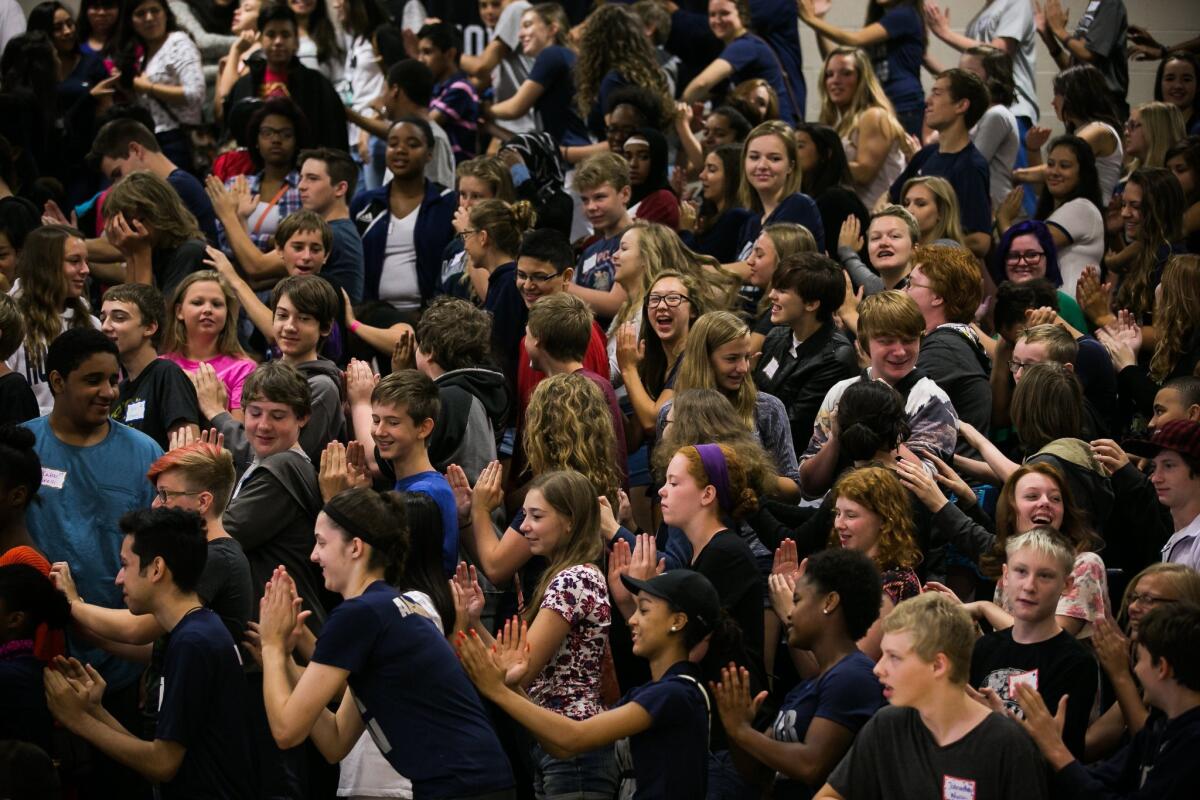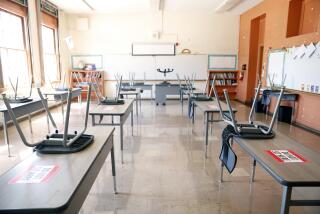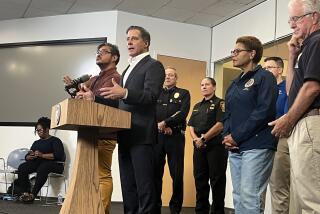Op-Ed: Back to school, again and again

Students, jokingly give each other a back massage as part of an ice breaker game during freshman orientation at Theodore Roosevelt High School on Aug. 20, in Des Moines, Iowa.
Even in places that remain in touch with the rhythms of agriculture, few seasonal markers prove as heady, reliable and poignant as the reopening of school. Every September the crosswalks ripen with kids in their back-to-school clothes; the long yellow buses harvest our lanes and streets. First the brightly colored backpacks and then, as if in imitation, the autumn leaves.
Everyone has a share in the emotions that accompany this time. Everyone whoâs been to school, everyone whoâs sent a child there, everyone whoâs ever taught knows some version of that queasy thrill. Having done all three, I know it on a fairly deep level, but itâs the ex-teacher in me who feels the back-to-school time most acutely.
People ask if I ever miss it, ever wish I was going back. The short answer, the one I usually give, possibly because itâs the opposite of what most people want to hear, is no. I donât miss the gnawing anxiety of late August, the readjustment to the school dayâs regimentation (I can go to the bathroom whenever I want now), the interminable staff development days, the briefcase swelling with papers. I donât miss the return to testing â of my studentsâ learning and of my own limitations. I donât miss handing back those first âFâs.â And I donât miss getting them.
I do miss the students, though. I miss seeing the growth that even a short summer can effect in the young. I miss the vitality. My approximation to an alcoholicâs need for a drink is a yen to chat with a kid. The average age of those I taught was 16, roughly the age of a sophomore, literally âa wise fool.â Iâve known some wise men and women in my time, and have met my share of fools, but thereâs an indescribable beauty to those still teetering between the two.
So I do miss it, yes, and I donât miss it, and I can actually put my finger on the point where the truth of both statements balances out. Itâs the point at which the sense of a fresh start and the desire for radical improvement meet.
September always found me possessed by the resolution that this year was going to be better than the last, in fact the best year to date. I was better prepared than Iâd ever been. Iâd assessed my past mistakes and was resolved not to repeat them. I knew my strengths and how to build on them. I had a set of new approaches I was raring to try. Let the young be frisky; I could rely on something better. I was in shape.
I imagine this is how a boxer must feel when the first bell sounds: invincible, resilient, fast on his feet. For a while, perhaps for the whole September round, that seems to be the case. Then comes the haymaker that dazes him. Then the flurry of punches that puts him on the ropes.
The boxer knows this is a possibility and the teacher knows it too. Entropy and accident, fire drills and flu are always waiting to bedevil the best-laid plans. The difference is that the boxer can hope for a quick knockout, whereas the only quick knockout that can come to a teacher is her own. The best she can hope for is to last a full 15 rounds and have a respectable scorecard at the end. Oh, but how the elation of September can seem like a dream come March. The trick, of course, is not to dismiss the dream once youâve been pummeled awake.
In the end this may be one of the chief lessons of school, for teachers and students alike, that progress is as provisional as it is possible, that it never comes without reversals, that the first burst of energy is never more important than a well-marshaled second wind.
And yet, to listen to the debate about âthe future of public educationâ is to recognize what slow learners most of us are. On the one side, the gloomy coroner with his postmortem on âour failing schoolsâ; on the other the glib cheerleader with a 10-point plan. Both sides belong to the sidelines; the loudest voices seldom come from those facing another September with a blackboard at their backs.
In few things are we less progressive than in our failure to understand the tentative nature of progress. Itâs the course we keep flunking. Itâs the course we keep having to take over again.
But we keep signing up, keep going to class, and the vision of kids pouring out of a school bus, generation after generation, reminds us why. I know of no other sight that pleads so persuasively for rededication, not only to the democratic project of a free, public and equal education for all, but to the intimately related project of making a just and sustainable world. If Nature hasnât given up on her best idea, then who are we to quit.
Garret Keizerâs book âGetting Schooled: The Reeducation of an American Teacherâ is now in paperback.
Follow the Opinion section on Twitter @latimesopinion and Facebook
More to Read
A cure for the common opinion
Get thought-provoking perspectives with our weekly newsletter.
You may occasionally receive promotional content from the Los Angeles Times.










